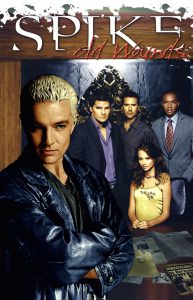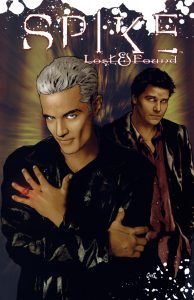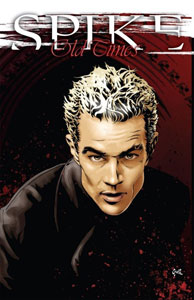Along with the “Angel” license, IDW also picked up the “Spike” license in 2005. Although there was never a “Spike” TV show, there were enough “Spike” comics that it can be treated as a distinct line, especially since the covers feature a “Spike” logo rather than the “Angel” logo. IDW tested the waters for the title with three double-length one-shots: “Old Times” (August 2005), “Old Wounds” (January 2006) and “Lost & Found” (April 2006).
All three one-shots feature art by Fernando Goni of Impacto Studios. As far as I can tell, he uses a computer program and starts from screen stills, then makes the images look more like drawn art. Some artifacts of the process can be seen, such as Spike’s hair being a direct cutout of his hair from a photograph. The likenesses are strong but a bit stiff or redundant. And because of the sparse backgrounds, these “Spike” titles – all set in “Angel” Season 5 — share a trait with IDW’s early “Angel” titles wherein Los Angeles seems underpopulated.
The joy of Peter David’s yarn is that it answers a burning question from “Older and Far Away” (“Buffy” 6.14). In that episode, Halfrek calls Spike “William” and – combined with the fact that Cecily and Halfrek are both played by Kali Rocha – fans surmised Halfrek was/is Cecily. However, the TV series was not interested in following that story further.
The novel “These Our Actors” (2002), which came out a few months after “Older and Far Away,” did not treat Cecily and Halfrek as one entity. In that book, Cecily is killed not long after her cruel dismissal of Spike, as seen in “Fool For Love” (B5.7). “Old Times” blatantly ignores that novel and is more in tune with what fans assumed, and hoped for, from “Older and Far Away.”
In this story, Spike’s need to help people clashes with Halfrek’s vengeance mission. That stuff is fairly rote – although the clincher to the arc of Halfrek’s target is a moment of remarkable dark humor. But the exchanges between Spike and Halfrek are delicious, and the story ends on a perfect zinger where Spike pretends to show interest in her, then says “You’re beneath me.” It’s a tasty spin on “vengeance” to conclude the ride.
4 stars

The opening head-scratcher of Scott Tipton’s “Old Wounds” is that a retired police detective believes he has gotten a break in the Black Dahlia mystery from 1947: Spike is his lead suspect.
What unfolds next is predictable, because since Spike says he didn’t do it, we know he didn’t do it; for all his faults, lying is not one of them. Fred believes him, and together they work to solve the case. It turns out that the Black Dahlia victims were killed by a demon, though, so according to Buffyverse spinoff fiction, both the Jack the Ripper (see “Tales of the Vampires” Issue 2) and Black Dahlia cases have supernatural explanations.

The rest of the Wolfram & Hart gang is doing research off-panel, but they feel absent from the proceedings, hardly getting any dialogue. This is defensible, as the title is “Spike” after all, but it’s jarring to see the gang just standing in the panels, speechless.
Tipton delivers some moments that capture the TV show’s rhythms, such as Spike prancing into Angel’s office in the middle of the meeting where the detective fingers Spike for the murders, and the twist ending where Spike figures out Eve had framed him.
On the other hand, the flashback to Spike’s time in 1947 includes a run-in with the Mexican wrestlers from “The Cautionary Tale of Numero Cinco” (“Angel” 5.6); it struck me as absurdly random, although you might enjoy it if you for some reason loved that episode.
3.5 stars

This is the third of four Buffyverse comics to use this title. Again penned by Tipton, it was originally going to be called “Old Habits,” which would’ve fit better with the other “Spike” one-shots. A vampire is out and about killing people during the daytime, apparently because he has the Gem of Amara, which we saw destroyed at the end of the “Harsh Light of Day” (B4.3)/“In the Dark” (A1.3) two-parter.
The explanation is not much of a twist: There are multiple Gems of Amara. But Tipton humorously shows that Harmony started this whole thing, having secretly nabbed a second gem when Spike found the first one, then selling it on “ePay,” oblivious to its power.
After standard detective work and fisticuffs by Angel and Spike close the case, Spike smashes this gem, thus repeating Angel’s arc from four years prior. On one hand, this is redundant writing; on the other hand, it illustrates how Spike is always in Angel’s shadow – making his own journey of redemption after Angel had already trod the path.
3.5 stars
Click here for an index of all of John’s “Buffy” and “Angel” reviews.

